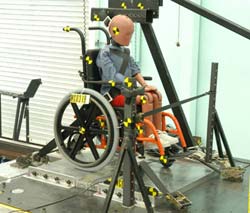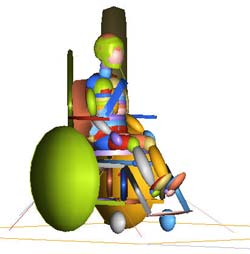Development and Validation of a Frontal Impact 6 year-old Wheelchair-seated Occupant Computer Model
Abstract
When children using wheelchairs are transported to schools and developmental facilities, they often remain seated in their wheelchairs in motor vehicles. However, there have been no studies published on safety of children using wheelchairs in transit. Three Sunrise Medical Zippie pediatric wheelchairs with a seated Hybrid III 6-year-old ATD were sled tested in accordance with the ANSI/RESNA WC-19 standard. Using sled test data, a computer model of the Zippie wheelchair with a seated Hybrid III ATD was developed and validated in MADYMO. This pediatric wheelchair model will be useful to study the response of manual pediatric wheelchairs in crashes and the associated injury risks for pediatric wheelchair users.
Keywords:
computer simulation, pediatric wheelchair, wheelchair transportation safety
Background
Disability related laws, such as the Americans with Disabilities Act and the Individuals with Disabilities Education Act, increase the number of disabled travelers who sit in their wheelchairs in public or private transportation. When children with disabilities are transported to schools and developmental facilities, they often remain seated in their wheelchairs in vehicles, such as school buses and family vans. However, wheelchairs are typically designed to provide mobility for the individual, and not to be used as vehicle seats. Therefore, to improve the safety of children seated in wheelchairs when traveling in vehicles, studies are needed to evaluate the crashworthiness of pediatric wheelchairs and the associated injury risk.
Computer simulation models have been developed and used in crash response studies involving wheelchairs and wheelchair occupants, and to study the risk of injury in wheelchair occupants [1] [2] . However, the computer models developed and used to-date represent adult wheelchairs, with an adult occupant (50 th percentile male). Pediatric wheelchair occupants respond differently in crashes, and the 50 th percentile male anthropomorphic test device (ATD) is not appropriate for representing younger populations. In addition, pediatric transit wheelchairs are subjected to different loading conditions in a crash than are adult transit wheelchairs. To study pediatric wheelchairs in transit or associated occupant injury risks, a computer model of a pediatric manual wheelchair with a seated Hybrid III 6-year-old ATD, was developed and validated in this study.
Research Objective
The goal of this study is to develop a pediatric manual wheelchair and child occupant computer crash simulation model in Madymo and validate the developed model using data collected during the sled tests.
Methods
Three Sunrise Medical Zippie pediatric wheelchairs having identical configuration (frame width and depth, caster size, rear wheel size, and seating systems) with the transit option were tested in accordance with the American National Standards Institute (ANSI)/Rehabilitation Engineering and Assistive Technology Society of North America (RESNA) WC-19, Wheelchairs for Use in Motor Vehicles , standard which requires a 20g/48kph frontal impact sled test [3] . An instrumented Hybrid III 6 –year-old ATD was positioned in an upright seated posture in the wheelchair and restrained with a surrogate, vehicle-anchored, three-point belt. (See Figure 1 (a)) The wheelchair was secured to the sled platform using a surrogate four-point, strap-type tiedown. Before conducting a sled test, measurements, such as the position of the wheelchair on the sled plat form, and tiedown and occupant restraint anchor points, were recorded from the test setup for use in the development of the computer model. Wheelchair acceleration, wheelchair rear tiedown forces, occupant restraint shoulder and lap belt forces, and ATD head and chest accelerations were collected during a sled tests. And, the entire impact event was also recorded using high-speed (1000 frames/sec) motion cameras positioned at the side of the sled track.
 |
 |
As shown in Figure 1 (b), using the measurements taken from the sled test setup, a computer model of the Zippie with a seated Hybrid III 6-year-old ATD was developed in Madymo. The computer model was tuned until the data generated from the computer simulation was a close match to the sled test data: trends and the peak of time history data from the computer simulation were matched to trends and the peak of time history data from the sled tests.
Results
Comparison between the sled test and the MADYMO model is shown in Figure 2. Trends of time histories generated from the computer simulation were well correlated to trends of those generated from the sled test in all variables . The peak value for each parameter is compared between the sled test and the model in Table 1. The % difference was calculated as | Sled Test Peak – Simulation Peak | / ( Sled Test Peak ). The % peak difference ranged from 2.1% to 14.4 % with the average % peak difference of 8.5 %.
 |
 |
 |
 |
 |
 |
Correlated Variable |
Sled test |
Model |
% peak difference |
|---|---|---|---|
WC x-acceleration (g) |
22.7 |
24.2 |
6.6 |
Rear-L tiedown force (N) |
3055 |
3275 |
7.2 |
Shoulder belt force (N) |
3862 |
3781 |
2.1 |
Lap belt force (N) |
2519 |
2778 |
10.3 |
Head acceleration (g) |
45.7 |
52.3 |
14.4 |
Chest acceleration (g) |
54.0 |
48.5 |
10.2 |
Average % peak difference (%) |
8.5 |
||
Discussion and Conclusions
A M adymo model representing a Zippie pediatric manual wheelchair seated with a Hybrid III 6-year-old ATD subjected to a 20g/48kph frontal crash was developed. The force-time and acceleration-time history profiles of the model were similar to those of the sled test. The peak % difference for all individual variables found in this study falls within the range presented in the previous studies of adult wheelchair computer models; 0.6% to 28.1% [1] [4] [5] .
Studies and research conducted to-date on wheelchair transportation safety have focused on adult wheelchair users, and there have been no studies published on children using wheelchairs in transit. This pediatric wheelchair model will be useful to study the response of a manual pediatric wheelchair in crashes and to study associated injury risks for pediatric wheelchair users.
References
- Bertocci, G.E., Szobota, S., Hobson, D. A., and Digges, K., Computer Simulation and Sled Test Validation of a Powerbase Wheelchair and Occupant Subjected to Frontal Crash Conditions. IEEE Transactions on Rehabilitation Engineering, 1999. 7 (2): 234-244.
- Leary, A. and Bertocci, G., Design Criteria for Manual Wheelchairs Used as Motor Vehicle Seats Using Computer Simulation . in RESNA . 2001. Reno, Nevada: RESNA Press.
- ANSI/RESNA Subcommittee on Wheelchairs and Transportation (SOWHAT), ANSI/RESNA WC/Vol 1: Section 19 Wheelchairs - Wheelchairs Used as Seats in Motor Vehicles . April 2000, ANSI/RESNA.
- Pilkey, W., Kang, W., and Shaw, G., Crash Response of Wheelchair-occupant systems in transport . in RESNA . 1994. Nashville, TN: RESNA Press.
- Leary, A.M., Injury risk analysis and design criteria for manual wheelchairs in frontal impacts , in Bioengineering . (Maters thesis) 2001, University of Pittsburgh: Pittsburgh.
Acknowledgements
This research was supported by the NIDRR RERC on Wheelchair Transportation Safety, (H133E010302). Opinions expressed are the authors and do not necessarily represent those of the funding agency.
DongRan Ha,
University of Pittsburgh,
Department of Rehabilitation
Science and Technology,
5055 Forbes Tower,
Pittsburgh, PA 15260,
412-383-6580,
dohst5+@pitt.edu
